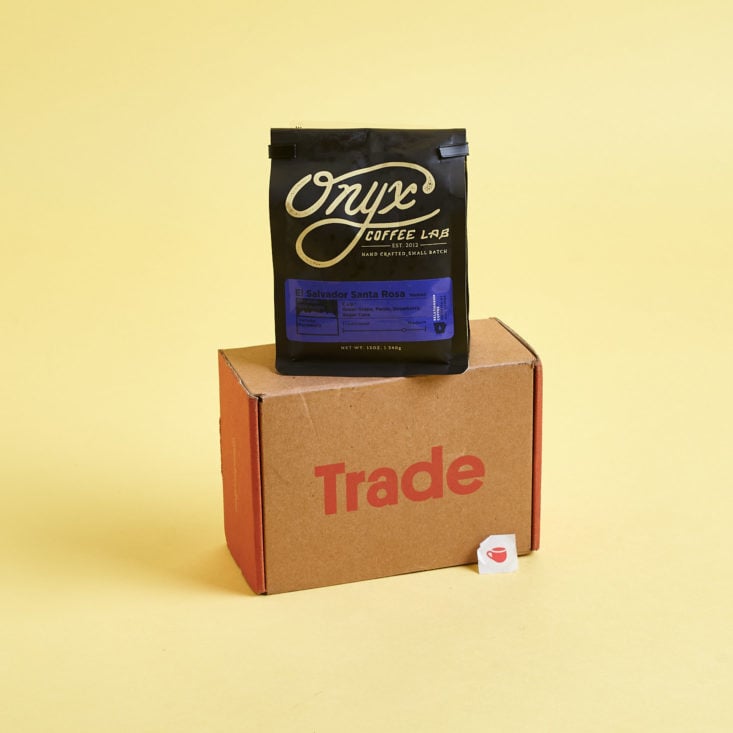
3 Things You May Not Know About Trade Coffee
From a Loyal Subscriber
Do you want to know more about craft coffee—perhaps learn the best coffee brewing methods or how to make cold brew coffee? Or, are you a serious coffee lover who’s already measured, ground, and brewed your beans, inhaled the aroma with your eyes closed (inner peace: achieved), consumed your coffee ritualistically from your favorite mug, and repeated the process at least once? Either way, you’re in the right place, because I’m about to celebrate a few aspects of Trade Coffee that I think are top-notch, in addition to the high-quality coffee I was introduced to by Trade last year. Here we go.
What Makes Trade Different from Other Coffee Subscriptions

Image from our review.
If you're new to Trade, or you want to learn more about their subscription options, I recommend heading over to my review. Otherwise, here's what I'll be covering in this article:
- Info about how Trade supports small batch coffee roasters
- An overview of Trade's at-home brew guides
- A shout out to Trade's updated eco-friendly shipping packaging
- Updated on 5/26/20 to mention that Trade is also phasing out their bingo stickers in an effort to further reduce their environmental inpact.
Small Batch Coffee Roasters
Trade matches subscribers with coffee from small roasters
All 50 of the coffee roasters that Trade works with have a handful of things in common:
- They're small businesses
- They ensure the farmers who grow their coffee receive quality wages
- They have a commitment to sustainability
- They make high-quality, delicious coffee
Does it get any better than that? For me—as someone who values both supporting local businesses and convenience—it does not.
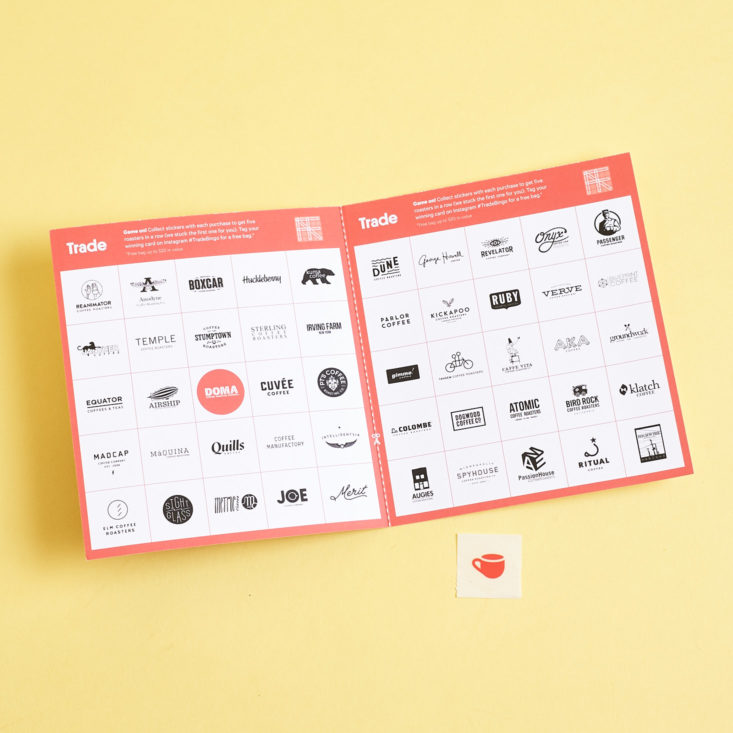
Image from our review.
I work from home, which means that what I consider to be "my office" and my favorite local coffee shops create a nice Venn diagram. It brings me joy to support small businesses in my community, and it's a wholly positive experience for more reasons than just the delicious coffee.
But I also love changing up routines & exploring new flavors, I get excited by thoughtful branding and cool packaging, and I appreciate learning about what folks are up to in other regions. So far I've been matched with coffees from roasters I probably never would have found carried in stores near me (from locations like Post Falls, Idaho and Santa Cruz, California), and I'm waiting with anticipation to be surprised by matches from Denver, Chicago, and Lancaster, where some of my beloveds live. Of course, you don't have to be a subscriber to get in on Trade's offerings—I could always place a one-time order from any of these places, but I like the element of surprise so I choose to wait.
Check out which indie coffee roasters are included on Trade's roster right here. To view by region, click the grey "Region" box.

Image via Trade.
Wondering what Trade Coffee is doing to support their roaster partners through the impacts of coronavirus?
- They're donating part of their sales to roaster employee funds, and their donations are being matched by Chobani. More info here.
- They're also encouraging virtual tipping to roasters via Venmo or GoFundMe. Tip a roaster here.
- They're now selling 5 pound bags of coffee knowing that folks are drinking more at home. Shop 5 lb. bags of coffee here.
How to Brew Coffee
Trade sets you up for success with how-to guides
If you read my Trade Coffee review, you may recall that back when I was living in the BT (Before Trade) times, I was making pour-over coffee using high-quality beans, but it wasn’t blowing my mind every day. I now know that your cup of coffee can and should blow your mind every day, and all credit goes to Trade both for matching me with flavors that suit my tastes and for providing me with the instructions on how to brew it effectively. I want this for you!
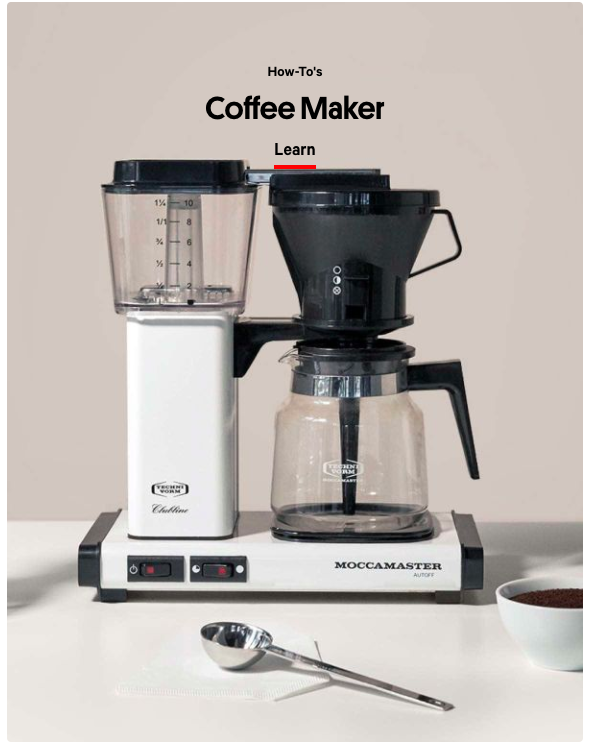
Image via Trade.
Trade offers brew guides for six different coffee-making methods. For each, there are simple instructions—but for those who want to really nerd out with it, there are details, too. Are you a slideshow-style learner? More of a list learner? Perhaps a visual learner? All of these options are represented.
Here’s what you can learn more about:
How to make coffee using a coffee maker
It seems impossible to mess coffee up using a coffee maker, but as Trade will teach you, it’s less about getting it wrong and more about getting it extra right. I may not have thought to look up instructions for how to optimize coffee maker coffee, but I’d like to share a few things I learned.
Question I didn’t know I had: What kind of water should I be using in my coffee maker?
Answer, per Trade:
- "If you can run your tap water through a basic water filter, that’ll produce the best results. Bottled water works great too! Distilled water won’t do a great job, as your water does need some minerals to extract those tasty flavors.”
Question I didn’t know I had: Can I control the flavor of my coffee?
Answer, per Trade:
- “If it’s more bitter than you’d like, you can grind coarser for your next batch, if it’s a little sour or not sweet enough, grind a little finer.”
How to make cold brew coffee
Did you know there’s more to cold brew coffee than just chilling coffee you already made? (Though that works, too.) If you want to embrace the art of it, the process is similar to making tea, and of course, Trade carries everything you need to nail it.
A tip from Trade:
- “Cold brew coffee requires a certain amount of patience (or at least forethought). Wait 12 to 18 hours; longer brew times will yield a richer concentrate, but steeping it more than 18 hours could cause bitter flavors. Because cold water extracts slower than hot water, you’ll need that time to get flavor into your brew.”
How to make coffee using a French press
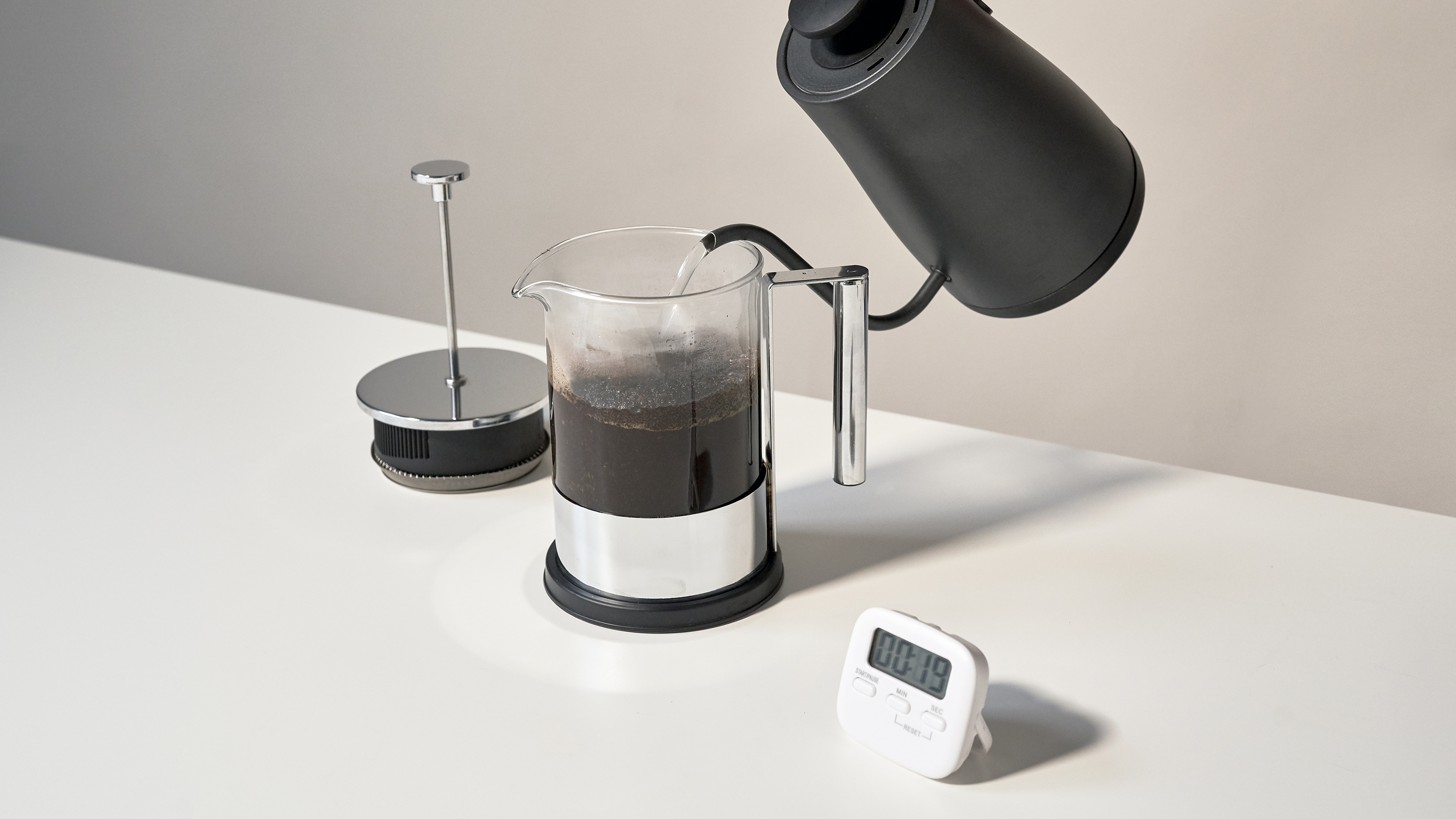
Image via Trade.
You may have heard of “blooming” your coffee grounds when using a pour-over technique. Did you know that blooming is a recommended practice when using a French press, too?
Tip from Trade:
- “You want to get all the grounds wet at as close to the same time as possible, so the water starts extracting flavor from them simultaneously. That even extraction will make the coffee taste more balanced and delicious. You may notice your grounds “growing” or bubbling in the hot water. This process is called blooming, and it helps prepare the grounds to be brewed to perfection.”
The only thing missing from this guide for me is how to remember not to tap your French press on the edge of your trash can when cleaning out your grounds—anyone else out there have a few broken plunger stems under their belt?
How to make coffee using a Chemex
Until delving into Trade’s brewing guides, I didn’t know the difference between a Chemex and a classic pour-over setup. They are indeed similar, but the Chemex—aside from being a design icon—uses a certain type of filter that’s a unique shape and a little thicker than other filters, which brings out the flavor in more acidic or floral light roast coffees. But, you can brew any type of coffee using a Chemex, and it will taste amazing once you have the technique down.
How to make pour-over coffee
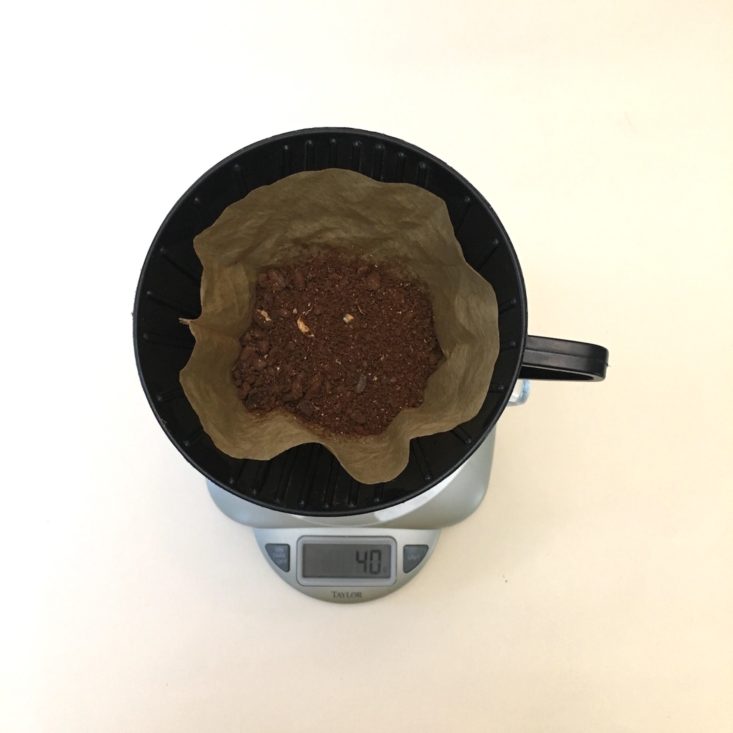
Image from our review.
Trade’s pour-over coffee guide taught me that pure coffee gold is easily achieved by measuring grounds and water, rather than eyeballing it. A food scale is recommended (the same is true for some of the previously listed coffee brewing methods), as well as a timer. It may seem like an overly complicated setup, but I am living proof that these minor adjustments become a pure joy, rather than a burden, when you taste how delicious the coffee turns out.
How to make iced coffee
There are a number of ways to make iced coffee, including just icing your coffee, but Trade outlines how to go about it in a way that avoids a stale flavor, minimizes dilution, and maintains caffeine strength.
In Trade’s words:
- “Because ice dilutes coffee, our recipe uses less brewing water to maintain the coffee’s flavor, taste, and caffeine strength as the ice melts. And since you’re not using cold water (which has trouble breaking down some of the roast’s flavor compounds), flash brewing ends up tasting brighter than cold brewing.”
See Trade’s full collection of brew guides here.
Sustainability
Trade recently updated their shipping supplies to be more eco-friendly
Spend enough time learning about the coffee industry and you'll find that it's a community that cares deeply about sustainability. There are tons of opportunities for green practices, from growing and harvesting to roasting and bagging, to shipping the product to coffee drinkers like you. Trade takes care to work with roasters who are committed to sustainable practices—they've even all signed this pledge.
Trade recently updated their packaging from cardboard boxes to compostable shipping bags that can be composted in your backyard, along with your coffee grounds*, as opposed to having to take it to a commercial facility—though that's still an option, too. They are colored red with vegetable dye and arrive containing your bag of coffee, your receipt, and a recyclable card with directions on how to compost the bag.
From Trade:
- "...what used to fill 12 trucks now fits on one! This translates to over four tons of reduced shipping weight a month. That adds up to around 50 tons annually, equal to 25 African elephants."
*Note on composting coffee grounds: coffee grounds add nitrogen to your compost. They can also be used as mulch, fertilizer, and a natural pesticide—they are beneficial because they allow nice drainage, water retention, and aeration in your soil. Do your research first, of course!

Image from our review.
One more thing! If you're a Trade subscriber or have been following along with my reviews, you may remember the bingo card that's sent with your first subscription shipment. Each subsequent shipment was promised to include a small coffee mug sticker so you could mark off the coordinating roaster on your card. When you get five in a row, you can snap a photo and send it to [email protected] to redeem a free bag of coffee (max of 2 redemptions per card).
Well, Trade recently stopped including those little bingo stickers in an effort to further reduce their environmental footprint, but the bingo game is still in play. They suggest you use a pen to make the appropriate marks on your bingo card instead! Once you get five in a row, it's the same process of simply snapping a photo and emailing it to the support team.
Do you love Trade as much as we do? What are your favorite features of this coffee delivery service?
Want to learn more about Trade? Check out our Trade review and Trade details.
Or, find other coffee subscriptions worth trying in this list!







Please do not enter your email address in the Name field or in the comment content. Your email address will not be published. Required fields are marked *. Remember to post with kindness and respect. Comments with offensive language, cruelness to others, etc will not be approved. See our full comment policy here.